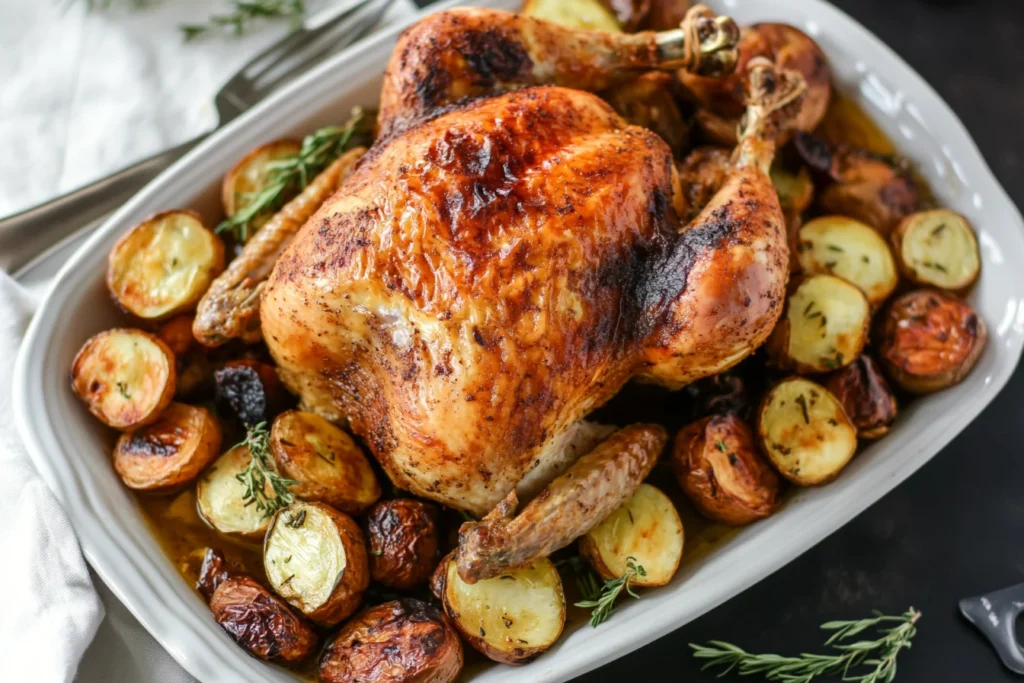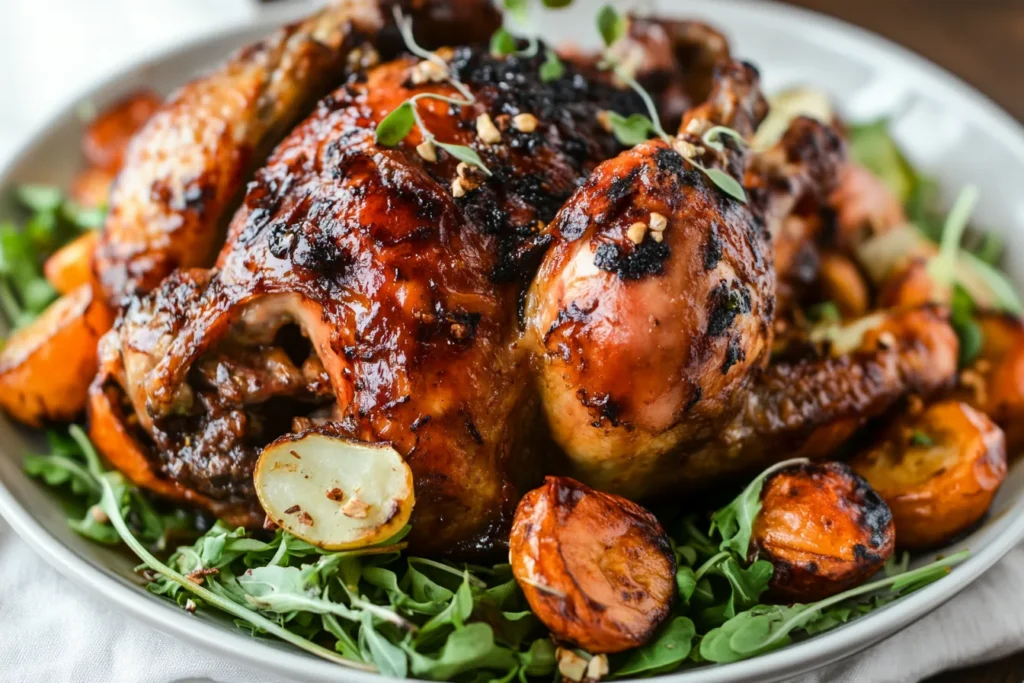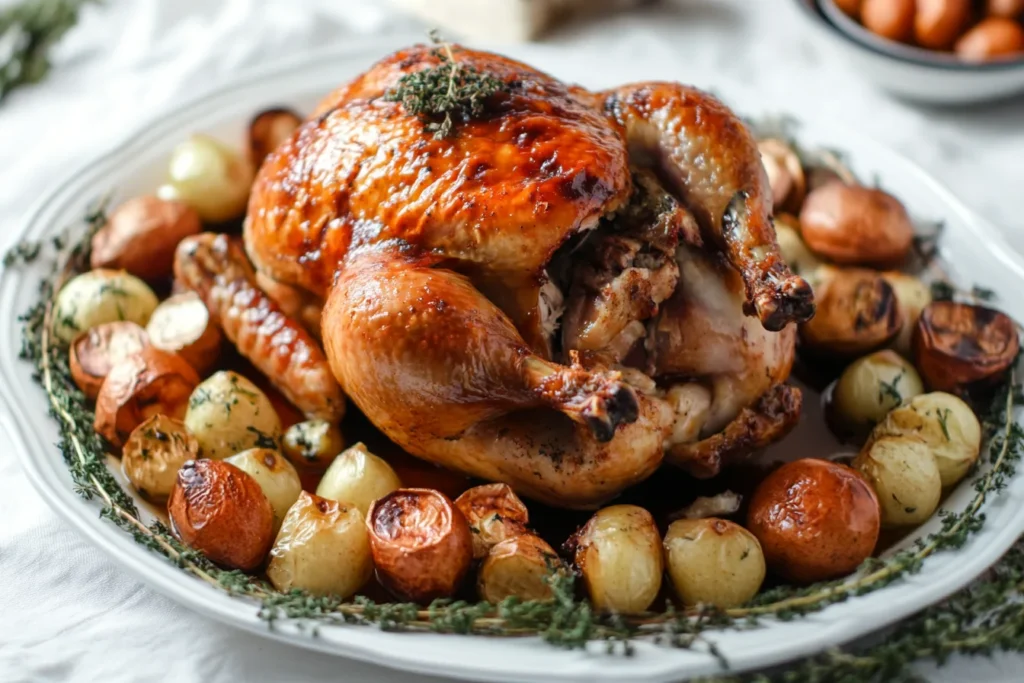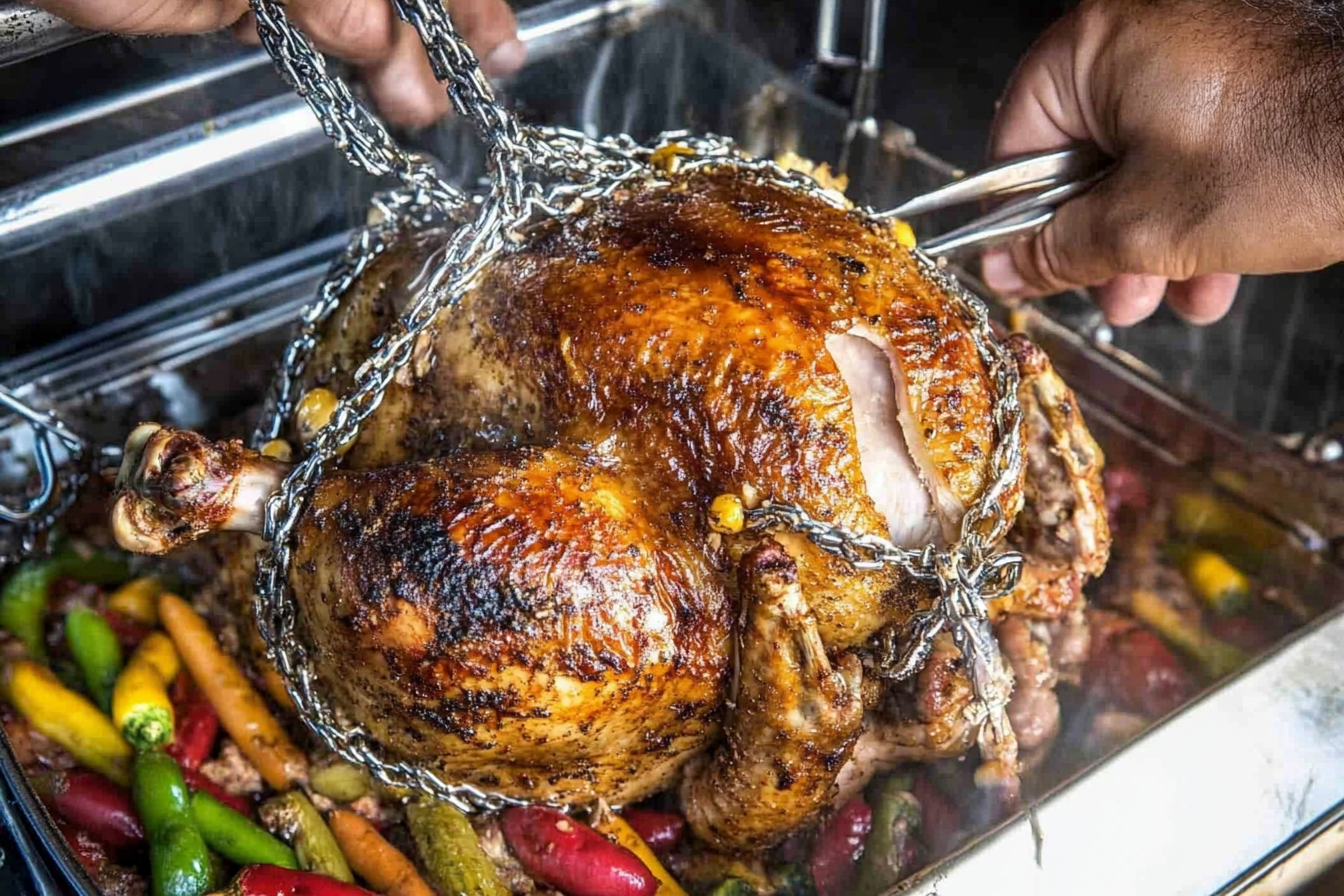1. Introduction to Rotisserie Chicken
History and Popularity of Rotisserie Chicken
Rotisserie chicken has been a beloved staple in kitchens worldwide for centuries. Its origins trace back to ancient methods of spit-roasting, where meat was cooked evenly over an open flame. This technique not only preserved moisture but also infused the meat with a smoky, caramelized flavor that appealed to every palate. In modern times, rotisserie chicken has become a symbol of convenience and deliciousness, readily available at grocery stores and restaurants.
Its popularity surged due to its versatility and affordability, making it a go-to meal for busy families and culinary enthusiasts alike. According to food industry reports, rotisserie chicken sales have consistently increased over the years, with grocery chains like Costco selling millions annually.
What Makes Rotisserie Chicken Special?
Rotisserie chicken stands out for its perfect blend of juiciness, crispiness, and rich flavor. The slow rotation during cooking allows the juices to distribute evenly, preventing dryness. Meanwhile, the caramelization of the skin, achieved through seasoning rubs or marinades, creates a golden-brown crust that is simply irresistible. It’s a meal that combines both comfort and sophistication, making it a favorite for diverse occasions.

2. The Science Behind Flavor in Rotisserie Chicken
How Cooking Technique Enhances Taste
The rotating spit used in rotisserie cooking is key to achieving its unique flavor profile. Unlike traditional roasting, this method ensures that the chicken bastes in its own juices while fat renders off evenly. This process prevents overcooking and maximizes the Maillard reaction—a chemical process that browns the chicken’s surface and creates those mouthwatering flavors.
Role of Marinades, Rubs, and Basting in Flavor Development
The addition of marinades, rubs, and frequent basting elevates rotisserie chicken from ordinary to extraordinary. Marinades penetrate the meat, introducing acidity and sweetness that enhance tenderness and taste. Common rubs often feature a mix of paprika, garlic powder, black pepper, and herbs, which create an aromatic crust during cooking. Meanwhile, basting with butter, oil, or stock locks in moisture, ensuring every bite is flavorful.
3. Exploring Common Ingredient in Rotisserie Chicken
Typical Marinade Ingredients
Rotisserie chicken owes its iconic taste to a mix of simple yet effective ingredients. Salt and pepper form the foundation, while other spices like garlic, paprika, and onion powder provide depth. Some recipes also include a touch of cayenne for heat or turmeric for a warm, earthy note.
Natural Enhancers: Citrus, Herbs, and Spices
Adding citrus juice (lemon or orange) to the marinade not only boosts flavor but also tenderizes the meat due to its acidic properties. Fresh herbs like rosemary, thyme, and parsley bring a fragrant, garden-fresh aroma. These natural ingredients ensure that the chicken is not only delicious but also free of artificial enhancers.
4. Identifying the “Secret Ingredient”
What Makes Rotisserie Chicken Stand Out?
While rotisserie chicken relies on classic spices, its “secret ingredient” often lies in a surprising addition. Some chefs use honey or brown sugar to enhance caramelization and add subtle sweetness to the skin. Others might opt for a dash of soy sauce or fish sauce, introducing a savory umami punch.
Commonly Overlooked Flavor Additives
One commonly overlooked additive is MSG (monosodium glutamate). Although controversial, MSG amplifies savory flavors, creating an umami-rich experience. Other overlooked yet impactful ingredients include smoked paprika, which adds a hint of smokiness, and apple cider vinegar, which brightens the overall flavor profile.
5. The Role of Brining in Flavor and Texture
Why Brining Is Essential
Brining involves soaking the chicken in a solution of water, salt, and optional flavorings before cooking. This step is crucial in achieving the signature juiciness of rotisserie chicken. Salt in the brine breaks down muscle proteins, allowing the meat to retain more moisture during cooking.
How Brining Adds Flavor and Moisture
A well-executed brine does more than prevent dryness—it infuses the chicken with deep, consistent flavor. Common brine ingredients like bay leaves, peppercorns, sugar, and garlic add complexity, while additional elements like citrus zest or cloves can create a customized flavor profile. The result? A chicken that’s moist, tender, and flavorful from the inside out.
6. The Mystery of Store-Bought Rotisserie Chicken
Store-Specific Recipes and Techniques
Ever wondered why rotisserie chicken from certain stores tastes better than others? It’s not just your imagination. Major retailers like Costco and Sam’s Club have fine-tuned their recipes, using proprietary blends of spices, marinades, and cooking techniques to ensure consistency and customer satisfaction.
Costco, for instance, is famous for its heavily seasoned rotisserie chicken, which features a balance of salt, savory herbs, and a touch of sweetness. The key to their flavor lies in their careful use of brining and a slow-cooking method that retains moisture. On the other hand, Whole Foods emphasizes organic and minimally processed ingredients, appealing to health-conscious consumers. These store-specific recipes are tailored to their target audience’s taste preferences, making them distinct.
Marketing Tactics: Highlighting Flavor Profiles
Many stores market their rotisserie chickens as “herb-roasted” or “honey-glazed” to highlight specific flavor profiles, enticing shoppers to make a purchase. Packaging often includes buzzwords like “juicy,” “homestyle,” or “chef-inspired,” which evoke the idea of premium quality and care. Behind the scenes, these chickens often contain flavor-enhancing techniques like marination injections or specialized roasting equipment, adding to their appeal.
7. Secrets from Top Chefs
Professional Tips for Home Rotisserie Chicken
Top chefs agree: the secret to replicating restaurant-quality rotisserie chicken at home lies in preparation. Start by using a high-quality bird, preferably free-range or organic, as this impacts the flavor significantly. To mimic the deep flavors of store-bought versions, chefs recommend dry-brining the chicken overnight with a blend of kosher salt, garlic powder, and dried herbs.
During cooking, a key tip is to baste the chicken every 20 minutes with a mixture of butter and stock. This ensures that the skin remains crisp while the meat stays moist. Additionally, chefs suggest using a thermometer to achieve perfect doneness—185°F in the thigh and 165°F in the breast.
Unique Ingredient Insights from Culinary Experts
Chefs often incorporate ingredients that are less common in traditional recipes to elevate the flavor. For instance:
- Miso paste: Adds a salty umami kick to the marinade.
- Ghee or clarified butter: Enhances the golden-brown crust due to its higher smoke point.
- Fresh ginger: Provides a subtle zing that pairs well with garlic and soy sauce.
These unique touches can transform a simple recipe into a gourmet experience.
8. Hidden Additives in Commercial Rotisserie Chickens
Common Preservatives and Flavor Boosters
While store-bought rotisserie chickens are delicious, they often come with a host of hidden additives that enhance flavor, texture, and shelf life. Common preservatives like sodium phosphate and potassium lactate are used to keep the meat tender and moist. Some brands may also use artificial flavor enhancers, such as MSG, to amplify savory notes.
Reading Labels: What Ingredients to Watch For
It’s important to check labels carefully to avoid unwanted additives. Here are some ingredients to be mindful of:
- Sodium levels: Excessive salt content can make these chickens less healthy.
- Sugar and syrups: Often added to create a caramelized finish but can increase calorie count.
- Artificial colors: These may be used to achieve a uniform golden-brown appearance.
Consumers seeking healthier options should look for labels that specify “no artificial flavors” or “minimally processed.”
9. The Role of Equipment in Achieving Perfect Flavor
Rotisserie Machines: Enhancing Cooking Process
Commercial rotisserie machines are designed to cook evenly by rotating the chicken slowly over a heat source. This process ensures uniform caramelization and moisture retention. Many of these machines also use infrared technology to speed up cooking without compromising flavor.
Using the Right Tools at Home for Better Flavor
For home cooks, achieving similar results requires the right tools. An oven with a rotisserie attachment is ideal, but alternatives like a rotisserie basket for outdoor grills or a countertop rotisserie machine work just as well. Pair these tools with a meat thermometer and a basting brush to achieve precision.

10. Unique Regional Variations of Rotisserie Chicken Recipes
Flavor Profiles from Around the World
Rotisserie chicken recipes vary widely across cultures, each offering a unique twist on the classic dish:
- Peruvian Pollo a la Brasa: Marinated with a blend of aji amarillo (yellow chili), cumin, garlic, and vinegar for a tangy, spicy flavor.
- Middle Eastern Shawarma-style Chicken: Uses spices like sumac, coriander, and allspice, often served with yogurt-based sauces.
- Caribbean Jerk Chicken: Features bold, spicy marinades made with scotch bonnet peppers, allspice, and thyme.
These variations highlight the versatility of chicken as a canvas for bold flavors.
Adapting Techniques for Local Tastes
Adapting these global techniques at home is simple. For instance, you can replicate Peruvian flavors by adding soy sauce and lime to your marinade or bring a Caribbean flair by incorporating a touch of cinnamon and nutmeg.
11. DIY Rotisserie Chicken at Home
Step-by-Step Guide to Preparing Rotisserie Chicken
Making rotisserie chicken at home may seem daunting, but with the right steps, you can achieve delicious results. Here’s a simple guide:
- Choose the Right Chicken: Opt for a whole bird, preferably organic or free-range, weighing around 3-4 pounds for even cooking.
- Brine for Moisture: Submerge the chicken in a brine solution of water, salt, sugar, and optional aromatics (like bay leaves and peppercorns) for at least 4 hours or overnight.
- Season Generously: Pat the chicken dry, then rub with a blend of spices like paprika, garlic powder, onion powder, and dried thyme.
- Truss the Chicken: Tie the legs and wings to ensure even rotation and cooking.
- Cook with the Right Equipment: Use a rotisserie oven or grill attachment to cook the chicken evenly, basting with butter or marinade every 20 minutes.
- Check for Doneness: Use a meat thermometer to confirm the internal temperature is 165°F for the breast and 185°F for the thighs.
- Rest and Serve: Let the chicken rest for 10-15 minutes before carving to lock in juices.
Customizing Your Flavor Profiles
Personalize your rotisserie chicken with unique marinades and rubs. For example:
- Asian-inspired: Use soy sauce, ginger, and sesame oil.
- Mediterranean: Add lemon, olive oil, and oregano.
- BBQ-style: Mix brown sugar, smoked paprika, and chili powder for a sweet and smoky finish.
12. Balancing Health and Flavor in Rotisserie Chicken
Nutritional Considerations
While rotisserie chicken is a convenient meal option, its nutritional value depends on preparation methods. Store-bought versions can be high in sodium and fat due to marinades and skin. A 3-ounce serving typically contains:
- Calories: 140-160
- Protein: 23-25 grams
- Sodium: 450-700 mg (varies by brand)
To make it healthier, remove the skin and avoid heavy sauces. Opt for seasoning blends with minimal salt and focus on natural flavors like herbs and citrus.
Using Healthier Ingredients Without Compromising Taste
Replace unhealthy additives with nutritious alternatives:
- Substitute butter with olive oil or avocado oil.
- Use fresh herbs instead of salt-heavy spice blends.
- Replace sugar with natural sweeteners like honey or maple syrup.
This way, you can enjoy a wholesome, flavorful rotisserie chicken without guilt.
13. Vegetarian and Vegan Rotisserie-Style Alternatives
Replicating Flavor Without Meat
Vegetarian and vegan diets don’t have to miss out on the rich flavors of rotisserie chicken. Plant-based alternatives include:
- Seitan or Tofu: Marinated with spices and roasted for a meaty texture.
- Jackfruit: Its fibrous texture mimics pulled chicken, making it perfect for rotisserie-style recipes.
- Cauliflower: Whole roasted cauliflower basted with a blend of olive oil, garlic, and smoked paprika serves as a delightful substitute.
Popular Plant-Based Substitutes
Innovative brands like Beyond Meat and Tofurky offer plant-based chicken options that can be seasoned and cooked like traditional rotisserie chicken. These products are high in protein and low in fat, providing a healthy, ethical alternative.
14. Debunking Myths About Rotisserie Chicken
Common Misconceptions and Truths
There are several myths surrounding rotisserie chicken. Let’s debunk a few:
- Myth: Rotisserie chicken is unhealthy. Truth: While some store-bought options are high in sodium, homemade versions can be healthy and nutrient-dense.
- Myth: It’s hard to replicate store-bought flavor at home. Truth: With proper brining, seasoning, and cooking techniques, you can achieve similar or even better results.
- Myth: Rotisserie chicken is only for dinner. Truth: It’s versatile enough for salads, sandwiches, and soups.
Separating Hype from Reality
While rotisserie chicken has a reputation for being a shortcut meal, its culinary potential goes far beyond convenience. By customizing the ingredients and cooking process, you can elevate this humble dish into a gourmet centerpiece.

15. Pairing and Serving Rotisserie Chicken
Perfect Side Dishes
Pairing the right sides enhances the flavor of rotisserie chicken. Here are some ideas:
- Classic Comfort: Mashed potatoes, gravy, and roasted vegetables.
- Healthy Options: Quinoa salad, steamed broccoli, or a fresh cucumber-tomato salad.
- Global Inspiration: Coconut rice (for an Asian twist) or pita bread with tzatziki (Mediterranean flair).
Beverage Pairings to Elevate the Experience
Pairing rotisserie chicken with the right drink can elevate your dining experience:
- White Wine: A crisp Sauvignon Blanc complements the chicken’s savory notes.
- Craft Beer: Pale ales or wheat beers balance the smoky flavors.
- Non-Alcoholic: Herbal iced tea or sparkling water with lime provides refreshing contrast.
16. Sustainability in Rotisserie Chicken Production
Ethical Sourcing of Ingredients
Consumers are increasingly prioritizing ethical and sustainable food choices. Look for rotisserie chicken labeled:
- Free-range: Ensures humane treatment of chickens.
- Certified Organic: Indicates no synthetic hormones or pesticides were used.
- Fair Trade or Local: Supports small-scale farmers and reduces carbon footprint.
Eco-Friendly Cooking Practices
To make your chicken more sustainable:
- Use reusable tools like silicone basting brushes.
- Opt for energy-efficient ovens or outdoor grills.
- Repurpose leftovers creatively to minimize food waste (e.g., chicken salads or broths).
17. Common Mistakes in Making Rotisserie Chicken
What to Avoid During Preparation
Avoid these common pitfalls:
- Skipping the brine: Leads to dry, bland meat.
- Overcrowding the oven: Reduces air circulation, preventing even cooking.
- Using uneven seasoning: Results in inconsistent flavor.
Solutions to Achieve Better Results
- Always let the chicken rest before carving to lock in juices.
- Use a thermometer to avoid undercooking or overcooking.
- Rotate the chicken periodically if your equipment doesn’t have automatic rotation.
18. Future Trends in Rotisserie Chicken Recipes and Techniques
Innovations in Flavor Development
The future of rotisserie chicken lies in bold, global flavors and healthier options. Trends include:
- Incorporating fermented ingredients like kimchi for tangy profiles.
- Using smoked salts for depth.
- Experimenting with zero-waste cooking, such as roasting with vegetable scraps for added flavor.
Modern Cooking Tools to Perfect the Process
Advancements in cooking technology are making it easier for home chefs to replicate professional results. Tools like smart thermometers and precision rotisserie machines allow for greater control, ensuring perfect flavor every time.
19. Frequently Asked Questions About Rotisserie Chicken
- What is the best way to reheat rotisserie chicken? Use an oven at 350°F, covered with foil to retain moisture.
- Can I freeze leftover rotisserie chicken? Yes, store it in airtight containers for up to 3 months.
- What’s the healthiest way to eat rotisserie chicken? Remove the skin and pair with vegetables or whole grains.
- Why is store-bought rotisserie chicken so tender? Brining and slow cooking techniques keep it moist.
- What’s the secret to crispy skin? Baste with butter and increase the heat towards the end of cooking.
- Can I use chicken for meal prep? Absolutely, it’s versatile and easy to store.
- What spices work best for rotisserie chicken? Paprika, garlic powder, thyme, and cumin are popular choices.
- Is rotisserie chicken keto-friendly? Yes, as long as it’s not glazed with sugar-heavy marinades.
- What’s the best equipment for chicken? A rotisserie oven or grill attachment works best.
- How do I avoid dry rotisserie chicken? Use a brine and avoid overcooking.
20. Conclusion: The Real “Secret” Behind Perfect Rotisserie Chicken
The secret to perfect rotisserie chicken lies in the balance of preparation, seasoning, and cooking techniques. From brining and marinades to selecting the right equipment, each step contributes to the rich, savory flavors we all love. By experimenting with global recipes and healthier ingredients, you can turn this classic dish into a personalized culinary masterpiece.
Related Article : How long is leftover rotisserie chicken good in the fridge?

